The Digital Conversion Unit (DCU) at the University of Michigan Library is the unit responsible for digitizing our materials and depositing them into repositories available at the library, such as HathiTrust, Digital Collections, Deep Blue Docs, and others to showcase the library’s collections online. Occasionally, DCU has the opportunity to contribute to digital library projects spearheaded by other institutions as well.
In 2020, the Emory Center for Digital Scholarship in Atlanta, Georgia reached out to U-M to contribute to the Sounding Spirit Digital Library (SSDL). SSDL is a digital library that documents a specific type of hymnody, songbooks and hymnals of sacred music from the American South. The books selected for SSDL reflect vernacular Southern worship from 1843-1932. They cut across different religious traditions and musical genres to show the diversity of sacred music styles and uses in this time period and region. SSDL seeks contributions from partner institutions on the strength of their holdings in Southern sacred music. In the first year of the pandemic, they asked the Bentley Historical Library, the University of Michigan Library, and the William L. Clements Library to contribute titles in our collections that they had identified which would expand the project’s holdings, making us project partners.
After five years of meetings, emails, scanning, processing, review, and upload, we are finally able to present the collection at SSDL and in HathiTrust!
U-M titles in SSDL categories
SSDL initially identified over fifty books from the Bentley, the Clements, and the U-M Library for the project. The selected books span nearly the entire range of the project: our earliest contribution added to the SSDL is Polished Pearls (1876), a song book for the use of Sunday schools, whereas the latest is New Songs of the Old Faith (1925).
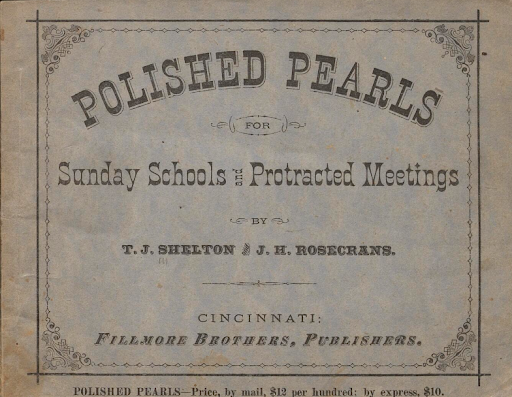
Front cover of Polished Pearls for Sunday Schools & Protracted Meetings, 1876 - the earliest published book from our contributions
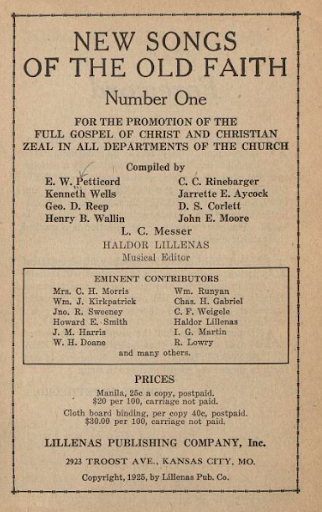
Front cover of New Songs of the Old Faith, 1925 - the latest published songbook from our contributions
The SSDL aims to highlight both the distinctiveness and the interconnectedness of several different genres and traditions, while emphasizing a few particular forms.
Shape-note music. Much nineteenth and early twentieth century music intended for communal singing was written in shape-note notation, where the distinctive shape of the note head denotes the correct pitch to the singer, without the need to understand key signatures and other complex notation. More information on shape-note music and the related Sacred Harp tradition of singing can be found in this recent Associated Press article. An example of shape-note music digitized from our collections is Gospel Songs (1909).
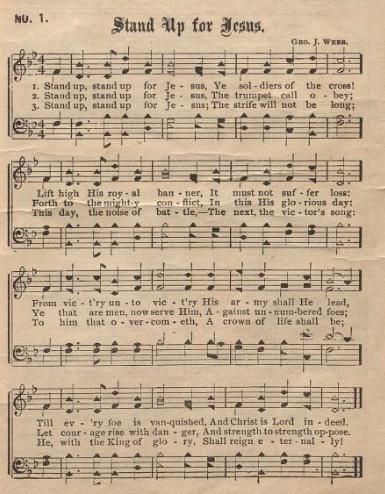
An image of the song Stand Up for Jesus from the shape-note songbook Gospel Songs, 1909
Gospel music and hymn singing. Whether accompanied by instruments or sung a cappella, these books of worship songs encompass a wide range of denominations and cultures, including texts in eleven languages. A selection of titles digitized by DCU may give some idea of this breadth: The Presbyterian Psalmodist (1855), Himnario de las iglesias evangelicas (1878), The Methodist Hymnal (1905), Tefilot Bene Yeshurun le-Rosh ha-shana (1866), and The Spiritualists’ Hymnal (1894). An example from our collection is the German-language Evangeliums-Lieder mit deutschen Kernliedern (1890).
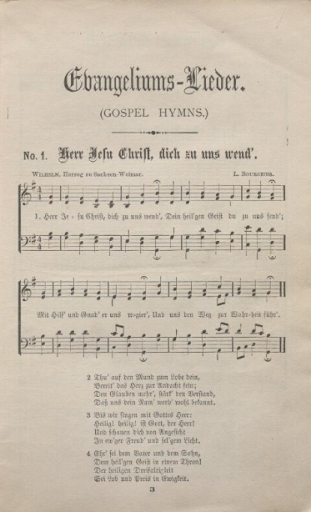
First page of the German language songbook, Evangeliums-Lieder mit deutschen Kernliedern, 1890
Sunday school music. DCU digitized a number of volumes of Sunday school music, intended for the education of children, including The Song Queen (1872), Good Tidings (1884), The Chorus of Praise (1898), and Sonntags-Schulen und christliche Familien (1879). Hall’s Songs of Home for Sabbath Schools, Etc. (1890) was selected for addition to the SSDL.
Spirituals. The University of Michigan contributed many books of spirituals collecting African American songs from the eras of slavery, Reconstruction, and later, including Jubilee Songs as Sung by the Jubilee Singers of Fisk University (1872), De Gospel Cars (1880), Slave Songs of the United States (1867), and The Hampton Series of Negro Folk-Songs (1919). One volume selected for inclusion in the SSDL is American Folk Songs, as Sung by Williams’ Jubilee Singers (1920), “The World’s Greatest Harmonizing Octette,” featuring a variety of spirituals both familiar (“Roll, Jordan, Roll,” “The Gospel Train”) and less so (“Wrestling Jacob,” “We’ll Stand the Storm”).
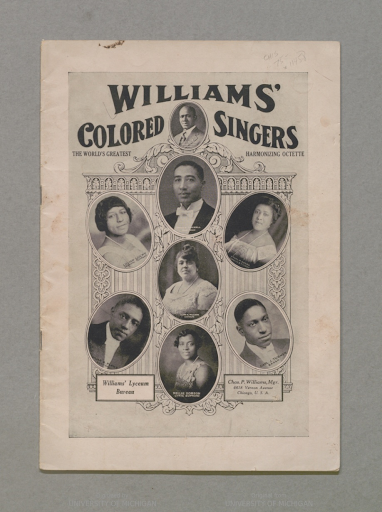
Front cover of the Williams' Colored Singers songbook, 1920
Other notable books recently digitized include devotionals for Civil War soldiers (The Soldier’s Manual of Devotion (1863)), two song books for the temperance movement (The National Temperance Songster (1854) and The Glorious Cause (1888)), and a musical adaptation of Bunyan’s Pilgrim’s Progress (The Singing Pilgrim (1866)).
Digitizing our materials for the SSDL
One of the benefits of U-M’s involvement in this project is that we’re no strangers to digitizing books en masse. The digitization equipment at the Clements and the U-M Library is more than capable of scanning all of the titles for this project, even the ones held in the Special Collections Research Center and the Bentley Historical Library.
Equipment used for the project included:
- i2s Copibook Open System (OS) XD book scanner
- Dell PC
- I2s LIMB Capture software for image capture
- Adobe Photoshop for image processing
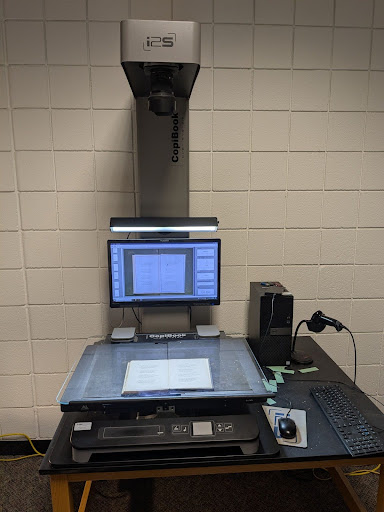
Image of the i2s Copibook OS XD overhead book scanner used for this project
Our digitization process for this project:
- Books are pulled from Buhr stacks, Bentley, Special Collections, Music Library, and elsewhere and delivered to DCU
- Book condition is evaluated for scanning concerns
- Books are scanned according to Sounding Spirit technical specifications
- Images are reviewed for quality, consistency, and completeness
- Images are processed and renamed according to Sounding Spirit specifications
- Images are packaged with BagIt software and delivered to SSDL via sFTP
Of course, the process is never entirely as straightforward as it seems. SSDL has a lot in common with U-M Library for digitizing books, but there were still some key differences that DCU had to take into account.
Managing divergences in digitization specifications
The SSDL has strict technical specifications for images submitted by partner institutions. These specifications accord with those developed by the Federal Agencies Digital Guidelines Initiative (FADGI). The specifications cover master file format (lossless TIFF), access file format (high quality JPEG), resolution (400 pixels per inch), 24-bit depth, and sRGB color space. The specifications presented no difficulty for DCU as we also follow FADGI guidelines in our digitization work.
The SSDL uses image capture specifications that vary from U-M Library’s:
-
Capturing out to 0.5 inch around the edge of each page and the book gutter with a black or gray background color;
-
Deskewing the pages to the page edges; and the inclusion of a color target at the beginning of each book to ensure color and lightning accuracy.
The deliverables would be 400 ppi high-quality JPEGs and named using SSDL’s project guidelines:
-
The folder was named as following [4 digit publication year]-[6 initial letters of the book title, excluding any leading articles]-[3-letter institutional ID].
-
Individual files end with a hyphen and a 4 digit sequential page counter.
-
Files were to be bagged using BagIt and then delivered via sFTP to the project server.
SSDL’s specifications vary slightly from U-M Library’s specifications in several ways:
-
DCU captures just outside the page edge and deskews to the text rather than the page edges.
-
Once review is complete, we provide the uncompressed 400 ppi TIFFs to the appropriate repository using a local high-speed network, where the platform server creates access files (typically as compressed JPEG2000).
-
We also do not include color targets with each book; instead we calibrate as prompted by our capture software to verify that the color accuracy and lighting levels remain consistent through sessions (we do include color targets and measurements for select archival materials).
-
For file naming, U-M Library uses the 14-digit barcodes from our library catalog to serve as the book/folder-level unique identifiers, while all pages are named using 8 digit sequential page counters.
The difference between SSDL and U-M Library’s specifications reflect the difference in our digital infrastructure. SSDL is collaborating with several institutions who have different ways of cataloging and identifying their materials, rather than having a singular source for bibliographic metadata and unique identification. Naming files by publication date, abbreviated title, and institutional ID is a great compromise, given the limited number of materials that could potentially overlap in filenames. Including color targets with each book allows SSDL to standardize color accuracy from different contributors.
Delivering sets of JPEGs as bags is a lot faster and more easily accomplished than delivering uncompressed TIFFs, given that project partners are uploading files through regional networks with different connection speeds rather than over a dedicated, high-speed local network. Also, the storage demands for TIFFs are far more expensive for the hosting institution. Ergo, while JPEGs are not a recommended preservation medium, they offer a reasonable compromise. SSDL’s image files provide high quality, high resolution images for patron and researcher needs at speed without placing a huge demand on storage and network bandwidth.
In order to accommodate SSDL’s specifications, DCU adapted our digitization practices for the project. Knowing we would want to deskew later, we expanded the margin around each image against a gray background to one inch. The image files were reviewed to ensure accurate and consistent color, lighting, focus, clarity, and completeness. We used Adobe Photoshop to deskew each page manually to the page edges, crop the borders uniformly down to a half inch from the pages edges and gutter, and then saved the TIFFs as 400 ppi high quality JPEGs. The files were renamed according to SSDL guidelines and uploaded to the SSDL project server using sFTP. Each upload was accompanied by an email to the project manager who verified the upload.
Doubling up on access and preservation
As the partners uploaded their contributions, Emory reviewed them all and chose the versions they felt best represented their interests, selecting seven titles from U-M to be shown in their online repository. At U-M, we realized that none of the titles scanned for this project had been included in the Google Books mass digitization project. So we also processed the scanned images according to our U-M Library digitization specifications and uploaded them to Google Books and HathiTrust. This duplicate effort ensures that the preservation image files we captured are stored in our repository, while acting as an indirect backup for our Sounding Spirit contributions.
Please visit the Sounding Spirit Digital Library website to learn more about the project goals and all partner contributions. Check out the HathiTrust collection which showcases all of the titles contributed by the Bentley Historical Library, U-M Library, and the William L. Clements Library.